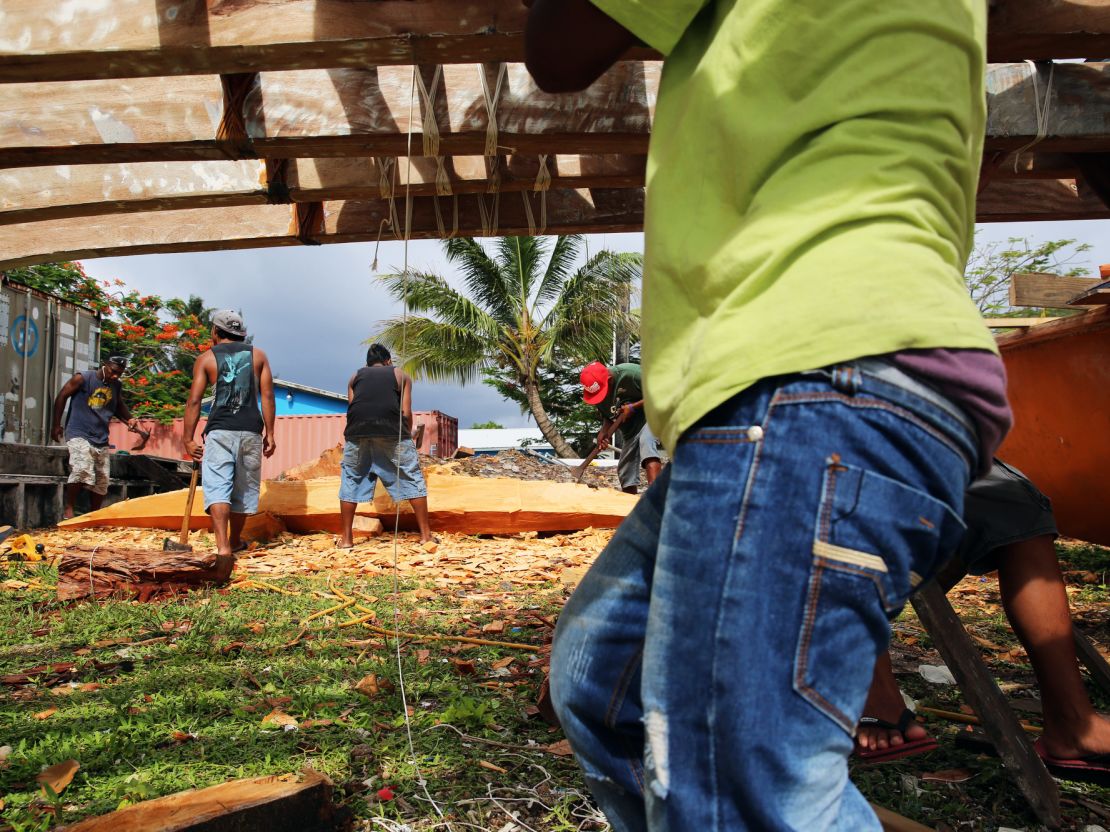Editor’s Note: CNN columnist John D. Sutter is reporting on a tiny number – 2 degrees – that may have a huge effect on the future. He’d like your help. Subscribe to the “2 degrees” newsletter or follow him on Facebook, Twitter and Instagram. He’s jdsutter on Snapchat. You can shape this coverage.
Story highlights
The Marshall Islands could disappear as sea levels rise
John Sutter recently traveled to that country as part of the Two° series
Swimming polar bears, melting ice caps.
You’ve heard that stuff.
But stop and think for a minute about the fact that climate change – which is my fault and yours, if you’re living in the industrialized world, where our carbon emissions are contributing to warming – actually could erase entire island nations from the map.
Countries like the Marshall Islands, which I recently visited for CNN’s Two° series, likely will be submerged or become uninhabitable if global temperatures rise 2 degrees Celsius above preindustrial levels.
How is that not seen as a moral issue?
Luckily, there’s still time to help. By cutting carbon emissions, we in the industrialized world can boost the odds that countries like the Marshall Islands will be able to survive.
Milan Loeak, a climate activist in the Marshall Islands, put this succinctly when I asked her where Marshallese people would move if they were displaced by rising seas.
“When people ask that it feels like defeat,” she said. “And I don’t want to feel defeated. I don’t want to entertain that question. I think people should be saying, ‘What can we do to help?’”
I agree. Here are five ideas about how you can help a nation survive.
1. STOP POLLUTING (or try to pollute a little less…)
Since I returned from the Marshall Islands, I can’t hear the hum of the air conditioner without thinking about the coal that’s burning to power my lifestyle – and how the carbon emissions associated with my electricity use are contributing to long-term sea level rise.
15 facts about sea level rise that should scare the s**t out of you
We as individuals likely can’t solve the climate change problem without help from governments and industry, but each of us can do our part to reduce our own fossil fuel emissions. Instead of feeling guilty about the pollution you create now, you should start feeling good about doing your part to pollute a little less. In the aggregate, it will make a big difference.
A few ideas about what you can do: turn your thermostat up in the summer and down in the winter; bike, walk or take public transportation; weatherize your home (there are financial incentives); buy electricity from green sources, where available; eat less meat, especially beef; and install solar panels.
Want more advice? Check out the Pope’s “10 commandments on climate change.”
2. Support efforts to keep Marshallese canoeing culture alive

This is depressing but true: There’s not much that people in the Marshall Islands can do to slow climate change and ensure that rising seas don’t submerge their nation. Carbon dioxide emissions from Pacific nations make up just 0.03% of the global total.
But (but!) that doesn’t mean people in the country are helpless.
They’re using their stories to try to raise global awareness – and to get the rest of us to realize, as one local poet told me, that “there are faces all the way out here.”
They’re also fighting climate change with a surprising weapon: culture.
Take Alson Kelen, director of a nonprofit called Waan Aelon in Majel, or Canoes of the Marshall Islands. He’s training dropouts to build canoes from local breadfruit trees. In doing so, he’s exposing them to the ancient Marshallese traditions of canoeing between the remote atolls that make up the country. He’s preserving a way of life – ensuring that at least one critical aspect of what it means to be Marshallese will survive even if, in the long term, the country doesn’t.
To support these efforts, check out WAM’s Facebook page and website, and consider a donation.
3. Encourage industrialized countries to welcome climate migrants
I met a family in the Marshall Islands that already decided to relocate – to Springdale, Arkansas, of all places – in part because they’re concerned about more frequent flooding and climate change.
These sorts of climate migrations likely are going to become more common, even if the world takes swift action to curb carbon emissions. In a twisted sense, the Marshallese are lucky: Because of the Compact of Free Association, they’re allowed to live and work in the United States legally. Citizens of Bangladesh, the Maldives and Kiribati – other nations where many poor people in low-lying areas are likely to be displaced – may not be able to legally move to another country. What happens if your island nation disappears and you have nowhere legally to go? That’s a question that should bother all of us, and to which we do not have an answer.
By international law, there’s no such thing as a “climate refugee.” You can’t claim asylum in another country because yours has been submerged.
I’d encourage you to raise this issue with the United States, the European Union and the United Nations and ask them to recognize the urgency of the coming climate migration crisis and to pledge to welcome would-be migrants should they want or need to come. Industrialized countries – the United States, China, Australia, those of the European Union – are causing climate change, and it’s our moral duty to welcome people who may be displaced by our callous indifference. There’s little sign to date, however, that we’ll do so.
4. Tell the world’s leaders 2 degrees is too much
Likewise, the industrialized world must act as quickly as possible to cut carbon emissions and to reduce deforestation rates so that fewer people will be displaced by rising sea levels.
Here are a few tangible ways you can encourage government action:
- Support the EPA’s Clean Power Plan.
- Vote for candidates who support cap-and-trade systems for carbon pollution, carbon taxes and energy efficiency subsidies. And, importantly, those that trust climate science.
- Support efforts to rid the world of fossil fuels by 2050, which is likely what’s needed, according to activists and analysts, to stop warming short of 2 degrees Celsius.
5. Join the “Keep it in the ground” movement
What if we could stop fossil fuels from coming out of the ground in the first place? That might be one way to ensure that the world stays below its carbon budget of 1,000 gigatonnes (about a quadrillion U.S. tons) – the amount of carbon we can pump into the air and still hope to stay short of 2 degrees of warming. The Guardian newspaper and 350.org, the activist group, have teamed up to rally people behind this concept, which they’re calling the “Keep it in the Ground” campaign.
I’d encourage you to check out their website to learn more.
Do you have an idea I didn’t mention? As always, feel free to email me – climate at cnn.com – or leave a comment at the bottom of this story. I’d also encourage you to sign up for the “2 degrees” newsletter if you want to find more ways to get involved in this coverage.























